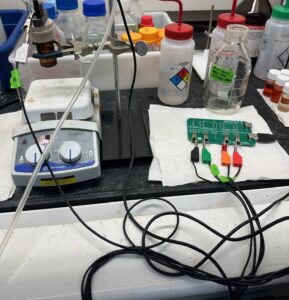Week Nine: Things Are Heating Up
May 3, 2024
Happy May, blog!
It’s starting to feel more like summer because it was so hot this week – both outside and inside MITRE. This entire week we’ve consistently gotten temperatures in the high 80s to low 90s; while driving, I constantly had the AC on full blast. In addition, it was also extremely toasty inside the Bio-Nano lab. On Monday, it was super warm in the conference room, and starting Tuesday, the lab itself was hot as well because the AC unfortunately broke. The lab staff are working hard to fix it, and two huge fans were brought in as substitute so at least the temperature wasn’t unbearable, but what a week for the AC to break.
Even with the whole AC fiasco in the lab, I performed three experiments this week. On Monday and Tuesday, I did two more control experiment with the bare electrode in the acid soak, and then I finished the week with a PFBS Water MIP experiment by fabbing (performing the fabrication) on Wednesday and sensing on Thursday.
The Monday experiment was an exact copy of the one I did last Thursday. I prepped the vial with 20 mL water and 200 uL HCl, and after characterizing the bare electrode before it spent time soaking in the vial, I let the electrode soak in the same vial and characterized every 40-minutes. The bare electrode spent a cumulative time of 120 minutes in the soak solution, so there were four data points for each 40-minute increment (0, 40, 80, 120).
My original intention was to carry out this experiment to 200 minutes, but I had to leave before I could get to that time point. Thus, this experiment ended up serving the purpose of seeing if my results are consistent with last week’s and being another trial of the acid soak Bare Dip series experiment. Comparing the trials, they both showed good stability and there was less than a 0.5 microamp net change in current for both. However, the net change in current was negative last week while the net change in current for my Monday trial was positive (something my other coworker was seeing as well).

On Tuesday, I had more time to complete the experiment, so I performed the same one with the bare electrode soaking in the water-acid soak for a total of 200 minutes. The current only decayed ever so slightly for the first 160 minutes and increased by a tiny amount during the 200-minute scan for a small net change of about -0.1 microamps. Overall, there’s still a lot to investigate regarding the background and electron mediator (ferrocene methanol) stability.
I worked with PFBS again the second half of the week, but this time the PFBS Water MIP was with a 10:1 ratio of o-PD:PFBS; last week’s was a 5:1 ratio. Something interesting I noticed was that during the Acid MIP Fabrication, there was an orange hue around with working electrode (see in image below). It stained the clear solution after I took the electrode out to characterize the full MIP in the ferrocene methanol. My coworker said she has also seen this during her experiments, but right now she’s not entirely sure why this occurs. For sensing, the electrode soaked in solution for a cumulative time of 160 minutes, and the t120 and t160 characterizations were sensing 250 ppb PFBS.

Oh, and an update regarding the lingering issue with the white wires I mentioned in previous posts: we finally found a solution for them! The lab bought a chipboard with several alligator clips, which serves as a different way to connect the screen-printed electrode to the potentiostat without having to use the fragile harness. An alligator clip is used to connect the reference electrode to the potentiostat (see in image below). Temporarily, there is only one in-use right now, but three more are expected to arrive and will eventually replace all the white wires.

I also plan to collect water samples this weekend so I can bring them into the lab next week. I hope to use the screen-printed electrodes on the samples, as the data collected would help me finish my final Senior Project product.
See you next week,
Fiona
Citations
All images: Fiona Xu

Leave a Reply
You must be logged in to post a comment.